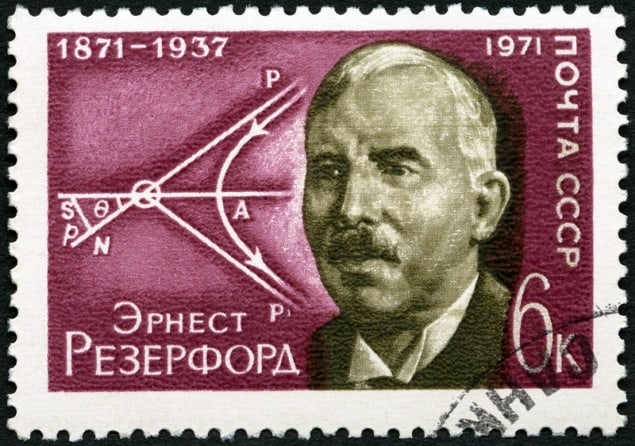With the 2022 Nobel prizes due to be announced, Physics World editors look at the physicists who’ve won prizes in fields other than their own. Here, Matin Durrani finds out how Ernest Rutherford scooped the Nobel Prize for Chemistry.

“I have dealt with many different transformations…but the quickest that I have met was my own transformation in one moment from a physicist to a chemist.”
So quipped the great New Zealand-born physicist Ernest Rutherford at the Nobel banquet in Stockholm in 1908 shortly after he had won that year’s Nobel Prize for Chemistry.
Rutherford, who at the time of his nomination was based at McGill University in Canada, had been awarded the chemistry prize “for his investigations into the disintegration of the elements, and the chemistry of radioactive substances”.
First as a postgraduate student at the University of Cambridge in the UK and then at McGill, Rutherford had shown that atoms are not stable but can radioactively disintegrate into other elements. In particular, by finding that thorium gives off a radioactive “emanation”, he discovered radon gas (we now know that thorium decays via radium into radon).
But the irony is that Rutherford had never formally studied chemistry. As a teenager at Nelson College in New Zealand, his best subject was mathematics and he had also taken courses in mechanics, sound and light. According to his biographer John Campbell, however, he “avoided chemistry, as he knew that the teacher was only one step ahead of the class”.
Later, as a master’s student at Canterbury College in Christchurch, Rutherford even turned down a suggestion for an experimental project that would involve looking for the molecular building blocks of life by studying electrical discharges in gases, as he felt he did not know enough chemistry.
Quite why Rutherford, the eminent physicist, should then have received a chemistry Nobel prize has been examined in detail by the theorist Cecilia Jarlskog from Lund University in Sweden, who dug into the Nobel archives.
She discovered that between 1907 and 1908, Rutherford actually received 12 nominations for a physics Nobel prize – and only four for chemistry.
In 1907 the Nobel Committee for Physics rejected Rutherford on the grounds that “his observation of the decay of a chemical element (radium) should be awarded with the chemistry prize rather than the physics Nobel prize.” As Jarlskog puts it, the physicists basically felt that “radium is a chemical element and that’s chemistry”.
The following year the chemists once again seemed keener on making Rutherford one of their own, with the chemistry committee going so far as to write an extensive, 15-page report on him. And they, of course, won the day.

Rutherford’s legacy
Then, as now, the message is that the dividing line between physics and chemistry is a human construct that nature does not respect. Of course, Rutherford could – and perhaps should – also have won a Nobel Prize for Physics for later discovering the atomic nucleus and for being able to transform one element (nitrogen) into another (oxygen). Indeed, he received 11 further nominations for the physics prize from 1912 onwards (and seven for chemistry).
But he didn’t and perhaps that serves him right. After all, Rutherford is famous for his cutting remark that: “All science is either physics or stamp collecting.”
We’ll see if any physicists win the 2022 Nobel Prize for Chemistry this year. If they do, they’ll have joined an eminent band that includes not just Rutherford but also other people who did physics or studied the subject at university, such as:
• Marie Curie (1911 for discovering radium and polonium);
• Alan Heeger (2000 for discovering and developing conducting polymers);
• Venkatraman Ramakrishnan (2009 for determining the structure and function of the ribosome);
• Eric Betzig, Stefan Hell and William Moerner (2014, for developing super-resolved fluorescence microscopy) and
• John Goodenough (2019, for developing lithium-ion batteries).
Physics World‘s Nobel prize coverage is supported by Oxford Instruments Nanoscience, a leading supplier of research tools for the development of quantum technologies, advanced materials and nanoscale devices. Visit nanoscience.oxinst.com to find out more.




